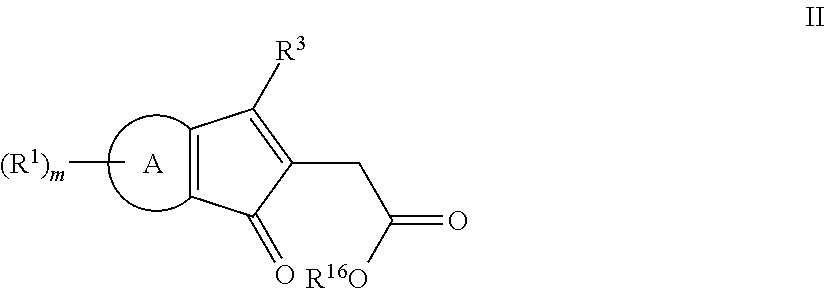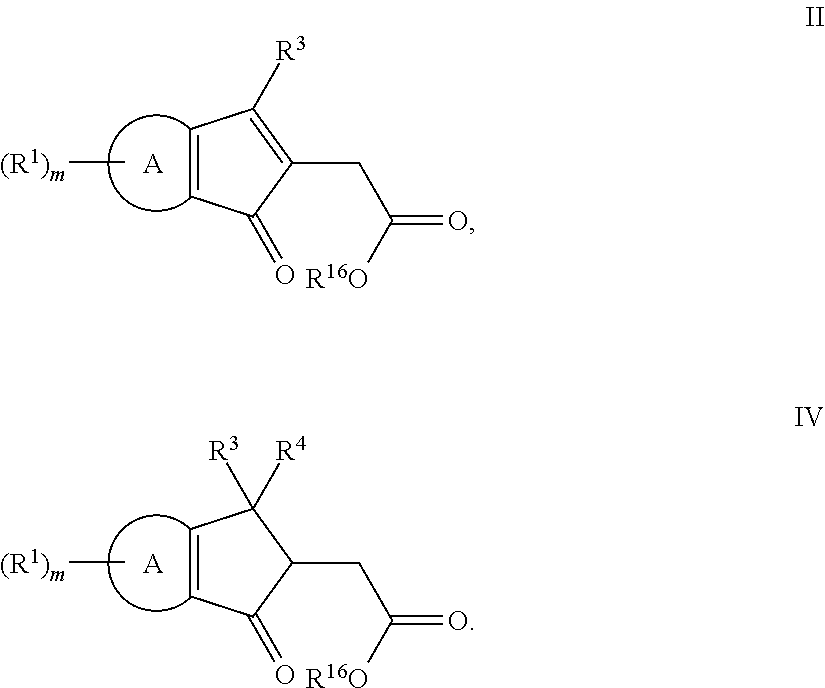Methods of making fused ring compounds
a technology of applied in the field of making fused rings and compounds, can solve the problems of reducing yields relative to the desired indeno-fused naphthol materials
- Summary
- Abstract
- Description
- Claims
- Application Information
AI Technical Summary
Benefits of technology
Problems solved by technology
Method used
Image
Examples
example 1
[0138]
Step 1
[0139]A mixture of 4-bromoacetophenone (148 g), dimethyl succinic ester (130 g) and toluene (2.5 L) was mechanically stirred in a reaction flask. Potassium t-butoxide (100 g) was added in one portion. A yellow color was observed and a lot of precipitate formed. One hour later, water (1 L) was added. The water layer was collected and washed with toluene (200 mL) twice. It was then acidified to pH 3 using 12 N HCl and extracted with ethyl acetate (1 L). The ethyl acetate solution was collected, dried over magnesium sulfate and concentrated. To the resulting viscous mixture, hexane (1 L) was added. A large amount of oil precipitated out and then crystallized. After filtration, white crystals (170 g) were obtained as the product. NMR showed that the product had a structure consistent with (E)-4-(4-bromophenyl)-3-(methoxycarbonyl)pent-3-enoic acid.
Step 2
[0140]The product of Step 1 (160 g) was mixed with 50% sodium hydroxide water solution (200 g) and water (4 liters) in a fou...
example 1a
[0147]
[0148]The product of Example 1 (3 g) was placed in a reaction flask. To the flask, 1-(4-fluorophenyl)-1-(4-(N-morpholino)phenyl)prop-2-yn-1-ol (2.1 g), 1,2-dichloroethane (30 ml) and p-toluenesulfonic acid (70 mg) was added. The mixture was refluxed for 4 hours, concentrated and passed through a silica gel plug column using 2 / 8 ethyl acetate / hexane as the solvent. A brownish oil (2 grams) was obtained as the product.
[0149]NMR showed that the product had a structure consistent with 3-(4-fluorophenyl)-3-(4-(N-morpholino)phenyl)-10-bromo-6-trifluoromethyl-13-methyl-13-butyl-3H,13H-indeno[2′,3′:3,4]naphtho[1,2-b]pyran.
example 2
[0150]
[0151]The procedures from Example 1 were followed except that: in Step 5, 1.4 M THF solution of methyl magnesium bromide was used in place of butyl magnesium bromide; in Step 6,1-bromo-4-trifluoromethoxybenzene was used in place of 1-bromo-4-trifluoromethylbenzene. NMR showed that the product had a structure consistent with 10-bromo-7,7-dimethyl-3-(trifluoromethoxy)-7H-benzo[c]fluoren-5-ol.
PUM
| Property | Measurement | Unit |
|---|---|---|
| temperature | aaaaa | aaaaa |
| temperature | aaaaa | aaaaa |
| temperature | aaaaa | aaaaa |
Abstract
Description
Claims
Application Information
 Login to View More
Login to View More - R&D
- Intellectual Property
- Life Sciences
- Materials
- Tech Scout
- Unparalleled Data Quality
- Higher Quality Content
- 60% Fewer Hallucinations
Browse by: Latest US Patents, China's latest patents, Technical Efficacy Thesaurus, Application Domain, Technology Topic, Popular Technical Reports.
© 2025 PatSnap. All rights reserved.Legal|Privacy policy|Modern Slavery Act Transparency Statement|Sitemap|About US| Contact US: help@patsnap.com



